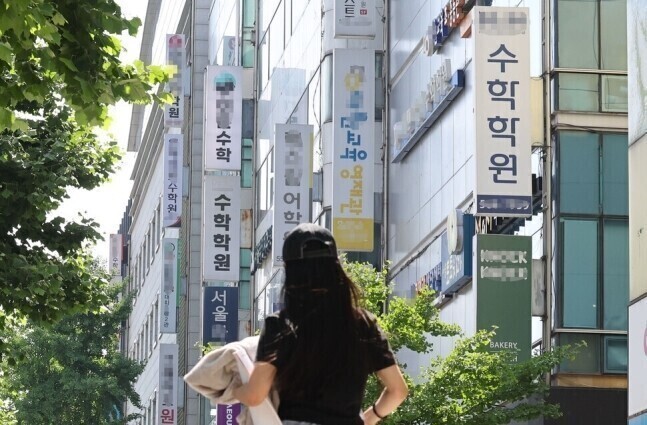An analysis by the Bank of Korea found that around 25% of the disparity in top university admissions can be attributed to differing levels of academic potential while the rest was parental economic power

A person walks through the Daechi area of Seoul, known for its private cram schools. (Baek So-ah/Hankyoreh)
Empirical analysis findings show that the socioeconomic background of students, rather than their academic potential, influences their chances of matriculating to high-ranking universities in Korea. The analysis suggests that students from high-income families perform better in university entrance exams due to their parents’ economic power and from living in regions recognized as “meccas” of private education institutions.
The Bank of Korea has proposed that high-ranking universities adopt admissions quotas based on regional school-age population ratios to address overly competitive university admissions and the inheritance of socioeconomic status.
The BOK published a report Tuesday titled “Social Problems Caused by Overly Competitive Entrance Examinations and Relevant Countermeasures,” in which it analyzed the results of admissions to the country’s top universities using a model cross-comparing parental income level, region of residence, and student’s academic potential.
Based on raw data from the Korean Education Longitudinal Study, which has been keeping annual track of a cohort of students who were in their first year of middle school in 2005, the report judged the academic potential of students by looking at their math scores from when they were in their first year of middle school and compared those statistics to which universities those students were attending in 2012. The high-ranking universities used as references included eight institutions in Seoul as well as medical, dental, Korean medicine, and veterinary schools nationwide.
The bank reported that “inequalities in education opportunities, such as differences in private education expenditure, are driven by income level of parents and region of residence rather than a student’s academic potential, which leads to a skewed enrollment phenomenon favorable to those living in Seoul.”
The analysis showed that enrollment in top universities was 1.5 times higher for those in the highest income quintile — the top 20% — than the next highest quintile, and 5.4 higher than for the lowest quintile. Even if students had the same academic ability, there was a significant difference in enrollment based on parental income.
When comparing the top 20% of families by income to the bottom 80%, the students within the top quintile (20.4%) were twice as likely as the bottom quintile (10.7%) to attend a top university, even if the two students had the same academic potential. Around 25% of the disparity in top university admissions can be attributed to differing levels of academic potential while 75% can be attributed to parental economic power, the central bank analyzed.
The disparity between residents of Seoul and those in other regions was staggering. In 2018, students from Seoul accounted for 16% of all high school graduates, but 32% of Seoul National University (SNU) students. Students from the three Gangnam districts — Gangnam, Seocho and Songpa — accounted for only 4% of all high school graduates, but 12% of SNU students.
The empirical analysis results showed that the rate of enrollment at SNU based on students’ academic potential was not significantly different between those from Seoul (0.44%) and those from other regions (0.40%), but the actual rate of matriculation at SNU was 2.6 times higher for Seoulites (0.85%) than non-Seoulites (0.33%).
The BOK estimated that the region of residence, which is impacted by parental income and influences access to private education, is responsible for 92% of the difference in Seoul students and non-Seoul students’ enrollment at SNU.
The BOK’s statistics show that the proportion of high school students from Seoul who went on to study at SNU increased from 0.9% in 2000 to 1.3% in 2018, while the proportion of students from rural areas (0.7% to 0.5%) decreased over the same period.
As a way to address admissions inequality, the bank proposed the introduction of admissions quotas based on regional school-age population ratios. The idea is to expand this selection system, which is currently in place in some universities, to most admission types for top universities.
“If universities voluntarily set aside a majority of their admissions seats to reflect the proportion of the school-age population in each region, they can reduce disparities caused by income and geographic factors and increase the admissions rate so that it accurately mirrors students’ potential,” the BOK explained.
The BOK found that placing restrictions on the proportion of successful applicants per region across the country to stand between 0.7 and 1.3 reduces the disparities in admissions to SNU and the admission rate based on academic potential by 64% (from 0.14 percentage points to 0.05 percentage points).
“While introducing a regional quota system would likely disadvantage marginalized groups in Seoul and benefit high-income families outside of Seoul, the benefits of reducing the impact of socioeconomic factors on admissions are likely to outweigh the disadvantages,” the report concluded.
By Kim Hoe-seung, senior staff writer
Please direct questions or comments to [english@hani.co.kr]

